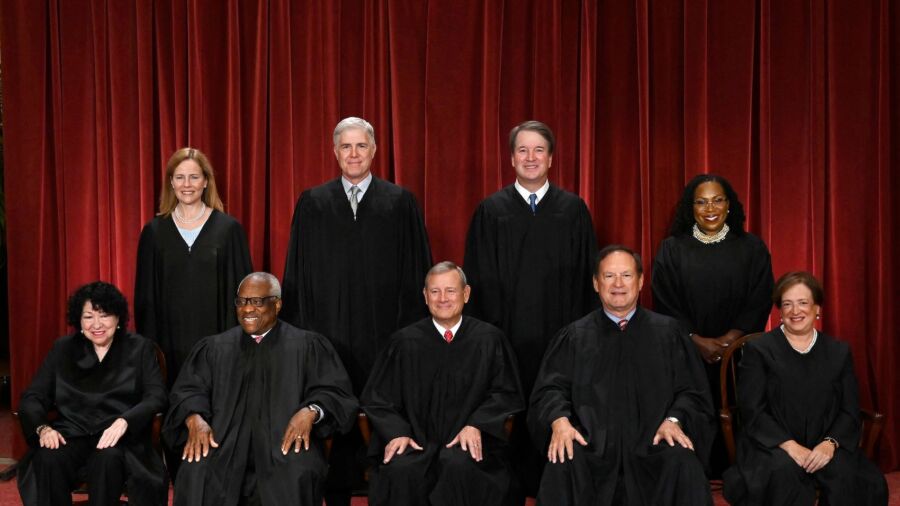The Supreme Court threw out on June 27 by a 7–2 vote a Colorado man’s conviction for making threats online against an entertainer because his intent in trying to communicate with her was never considered.
The case raised an important First Amendment issue in an age when so much communication takes place online using text, a medium that lacks the nonverbal cues present in in-person communication and that sometimes makes it difficult to ascertain the intent of the speaker.
Colorado’s stalking law forbids “knowingly … [r]epeatedly … mak[ing] any form of communication with another person … in a manner that would cause a reasonable person to suffer serious emotional distress and [that] does cause that person … to suffer serious emotional distress.”
The Supreme Court agreed in January to hear the case because courts across the country differ widely in how they interpret what constitutes a “true threat” under the U.S. Constitution.
To establish that a statement is a true threat that is not protected by the First Amendment, prosecutors must demonstrate that the speaker subjectively knew or intended the threatening nature of the statement, or that it is sufficient to show that a “reasonable person” would regard the statement as a threat of violence.
Billy Ray Counterman was convicted of stalking under Colorado law after he repeatedly contacted singer-songwriter Coles Whalen over two years using various Facebook accounts. Whalen never responded and blocked Counterman, but he kept creating new profiles to contact her.
Counterman was sentenced to four and a half years in prison.
Among the messages were: “Was that you in the white Jeep?” and “I’m currently unsupervised. I know, it freaks me out too, but the possibilities are endless.”
Counterman also wrote Whalen saying, “You’re not being good for human relations. Die. Don’t need you,” and “Staying in cyber life is going to kill you. Come out for coffee. You have my number.”
Justice Elena Kagan wrote the majority opinion (pdf) in Counterman v. Colorado (court file 22-138), which was joined in full by Chief Justice John Roberts, along with Justices Samuel Alito, Brett Kavanaugh, and Ketanji Brown Jackson. Justices Sonia Sotomayor and Neil Gorsuch joined the opinion in part.
Justices Clarence Thomas and Amy Coney Barrett both filed separate dissenting opinions. Thomas joined Barrett’s opinion.
“True threats of violence are outside the bounds of First Amendment protection and punishable as crimes,” Kagan wrote for the court.
“Today we consider a criminal conviction for communications falling within that historically unprotected category.
“The question presented is whether the First Amendment still requires proof that the defendant had some subjective understanding of the threatening nature of his statements.
“We hold that it does, but that a mental state of recklessness is sufficient. The State must show that the defendant consciously disregarded a substantial risk that his communications would be viewed as threatening violence. The State need not prove any more demanding form of subjective intent to threaten another.”
“The state had to show only that a reasonable person would understand his statements as threats,” Kagan wrote.
“It did not have to show any awareness on his part that the statements could be understood that way. For the reasons stated, that is a violation of the First Amendment.”
The Supreme Court vacated the judgment of the Colorado Court of Appeals and remanded the case to that court “for further proceedings not inconsistent with this opinion.”
Sotomayor wrote that the United States has “a tradition of criminalizing threats stretching back centuries.”
“Such laws are plainly important. There is no longstanding tradition, however, of punishing speech merely because it is unintentionally threatening,” she wrote.
“Instead, this Court’s precedent, along with historical statutes and cases, reflect a commonsense understanding that threatening someone is an intentional act.”
It is not necessary to show “an individual intends to carry through with the threat. But it does require showing that an individual desires to threaten or is substantially certain that her statements will be understood as threatening.”
But here the court deviates from “this traditional understanding,” the justice wrote.
“Where I part ways with the Court is that I would not reach the distinct and more complex question whether a mens rea of recklessness is sufficient for true-threats prosecutions generally.”
Mens rea is a Latin phrase meaning “guilty mind,” or criminal intent.
“Further, requiring nothing more than a mens rea of recklessness is inconsistent with precedent, history, and the commitment to even harmful speech that the First Amendment enshrines. I therefore respectfully concur only in part and in the judgment,” Sotomayor wrote.
In her dissent, Barrett wrote that the majority has adopted “a subjective standard,” but not the one argued by Counterman.
“The Court holds that speakers must recklessly disregard the threatening nature of their speech to lose constitutional protection. Because this unjustifiably grants true threats preferential treatment, I respectfully dissent,” she wrote.
From The Epoch Times

